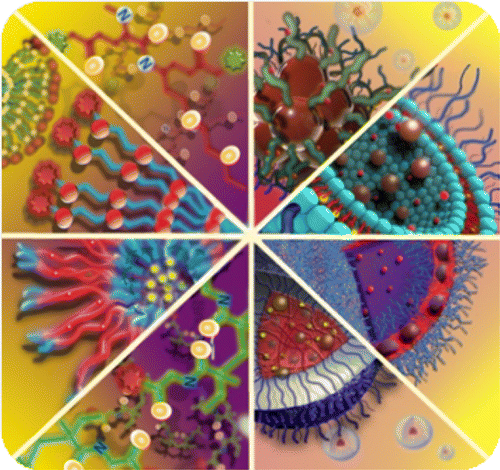当前位置:
X-MOL 学术
›
Chem. Rev.
›
论文详情
Our official English website, www.x-mol.net, welcomes your feedback! (Note: you will need to create a separate account there.)
Targeted Drug Delivery with Polymers and Magnetic Nanoparticles: Covalent and Noncovalent Approaches, Release Control, and Clinical Studies
Chemical Reviews ( IF 51.4 ) Pub Date : 2016-04-25 00:00:00 , DOI: 10.1021/acs.chemrev.5b00589 Karel Ulbrich 1 , Kateřina Holá 2 , Vladimir Šubr 1 , Aristides Bakandritsos 2 , Jiří Tuček 2 , Radek Zbořil 2
Chemical Reviews ( IF 51.4 ) Pub Date : 2016-04-25 00:00:00 , DOI: 10.1021/acs.chemrev.5b00589 Karel Ulbrich 1 , Kateřina Holá 2 , Vladimir Šubr 1 , Aristides Bakandritsos 2 , Jiří Tuček 2 , Radek Zbořil 2
Affiliation

|
Targeted delivery combined with controlled drug release has a pivotal role in the future of personalized medicine. This review covers the principles, advantages, and drawbacks of passive and active targeting based on various polymer and magnetic iron oxide nanoparticle carriers with drug attached by both covalent and noncovalent pathways. Attention is devoted to the tailored conjugation of targeting ligands (e.g., enzymes, antibodies, peptides) to drug carrier systems. Similarly, the approaches toward controlled drug release are discussed. Various polymer–drug conjugates based, for example, on polyethylene glycol (PEG), N-(2-hydroxypropyl)methacrylamide (HPMA), polymeric micelles, and nanoparticle carriers are explored with respect to absorption, distribution, metabolism, and excretion (ADME scheme) of administrated drug. Design and structure of superparamagnetic iron oxide nanoparticles (SPION) and condensed magnetic clusters are classified according to the mechanism of noncovalent drug loading involving hydrophobic and electrostatic interactions, coordination chemistry, and encapsulation in porous materials. Principles of covalent conjugation of drugs with SPIONs including thermo- and pH-degradable bonds, amide linkage, redox-cleavable bonds, and enzymatically-cleavable bonds are also thoroughly described. Finally, results of clinical trials obtained with polymeric and magnetic carriers are analyzed highlighting the potential advantages and future directions in targeted anticancer therapy.
中文翻译:

用聚合物和磁性纳米粒子靶向药物递送:共价和非共价方法,释放控制和临床研究
靶向给药与药物的控制释放在个性化药物的未来中起着举足轻重的作用。这篇综述涵盖了基于各种聚合物和磁性氧化铁纳米粒子载体的被动和主动靶向的原理,优缺点和缺点,这些载体均通过共价和非共价途径连接了药物。致力于将靶向配体(例如酶,抗体,肽)与药物载体系统的定制缀合。类似地,讨论了控制药物释放的方法。各种基于聚合物-药物的缀合物,例如基于聚乙二醇(PEG),N关于给药药物的吸收,分布,代谢和排泄(ADME方案),研究了-(2-羟丙基)甲基丙烯酰胺(HPMA),聚合物胶束和纳米颗粒载体。根据涉及疏水和静电相互作用,配位化学和包裹在多孔材料中的非共价载药机理,对超顺磁性氧化铁纳米粒子(SPION)和凝聚磁簇的设计和结构进行了分类。还对药物与SPION的共价结合原理进行了详尽描述,其中SPION包括热和pH降解键,酰胺键,氧化还原可裂解键和酶可裂解键。最后,
更新日期:2016-04-25
中文翻译:

用聚合物和磁性纳米粒子靶向药物递送:共价和非共价方法,释放控制和临床研究
靶向给药与药物的控制释放在个性化药物的未来中起着举足轻重的作用。这篇综述涵盖了基于各种聚合物和磁性氧化铁纳米粒子载体的被动和主动靶向的原理,优缺点和缺点,这些载体均通过共价和非共价途径连接了药物。致力于将靶向配体(例如酶,抗体,肽)与药物载体系统的定制缀合。类似地,讨论了控制药物释放的方法。各种基于聚合物-药物的缀合物,例如基于聚乙二醇(PEG),N关于给药药物的吸收,分布,代谢和排泄(ADME方案),研究了-(2-羟丙基)甲基丙烯酰胺(HPMA),聚合物胶束和纳米颗粒载体。根据涉及疏水和静电相互作用,配位化学和包裹在多孔材料中的非共价载药机理,对超顺磁性氧化铁纳米粒子(SPION)和凝聚磁簇的设计和结构进行了分类。还对药物与SPION的共价结合原理进行了详尽描述,其中SPION包括热和pH降解键,酰胺键,氧化还原可裂解键和酶可裂解键。最后,













































 京公网安备 11010802027423号
京公网安备 11010802027423号